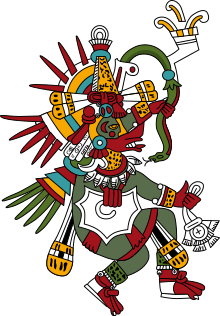Ometochtli
In Aztec mythology, Ometochtli is the collective or generic name of various individual deities and supernatural figures associated with pulque (octli),[1] an alcoholic beverage derived from the fermented sap of the maguey plant.[2] By the Late Postclassic period of Mesoamerican chronology a collection of beliefs and religious practices had arisen in the context of the manufacture and ritualistic consumption of the beverage, known as the "pulque (or octli) cult" with probable origins in a mountainous region of central Mexico. In Aztec society octli rituals formed a major component of Aztec religion and observance, and there were numerous local deities and classes of sacerdotes ("priests") associated with it.[3]

"Ometochtli" is a calendrical name in Classical Nahuatl, with the literal meaning of "two rabbit".
See also
- Centzon Totochtin
- Mayahuel
- Tepoztecatl
- Macuil-Tochtli
- Pulque
- Aztec mythology
Notes
- The origins of the word pulque are uncertain. Octli is the (Nahuatl) name by which the beverage is referred to in corresponding historical texts of the post-conquest period.
- Aguilar-Moreno 2007, p.149; Miller & Taube 1993, p.136
- Smith 2003, p.88
References
- Aguilar-Moreno, Manuel (2007). Handbook to Life in the Aztec World. Oxford and New York: Oxford University Press. ISBN 978-0-19-533083-0. OCLC 81150666.
- Miller, Mary; Karl Taube (1993). The Gods and Symbols of Ancient Mexico and the Maya: An Illustrated Dictionary of Mesoamerican Religion. London: Thames & Hudson. ISBN 0-500-05068-6. OCLC 27667317.
- Sahagún, Bernardino de (1997) [ca.1558–61]. Primeros Memoriales. Civilization of the American Indians series vol. 200, part 2. Thelma D. Sullivan (English trans. and paleography of Nahuatl text), with H.B. Nicholson, Arthur J.O. Anderson, Charles E. Dibble, Eloise Quiñones Keber, and Wayne Ruwet (completion, revisions, and ed.). Norman: University of Oklahoma Press. ISBN 978-0-8061-2909-9. OCLC 35848992.
- Smith, Michael E. (2003). The Aztecs (2nd edn. ed.). Malden, MA: Blackwell Publishing. ISBN 0-631-23015-7. OCLC 48579073.
